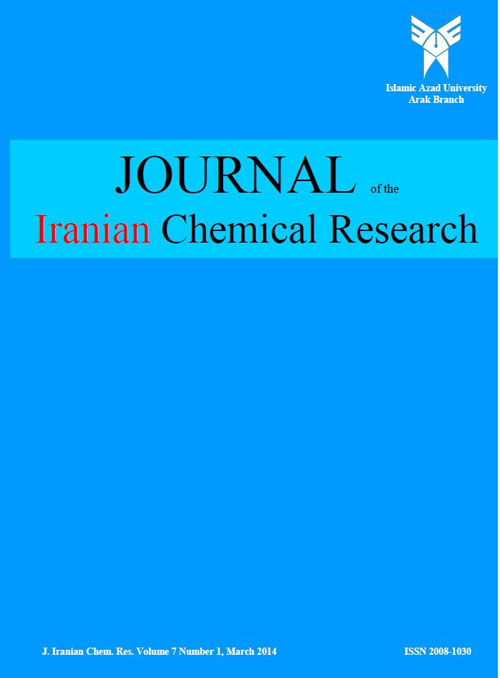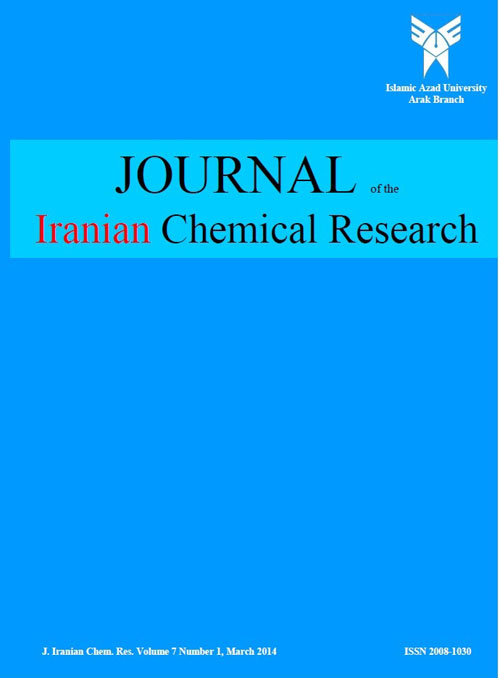فهرست مطالب

Journal of the Iranian Chemical Research
Volume:3 Issue: 3, Summer 2010
- تاریخ انتشار: 1389/06/30
- تعداد عناوین: 8
-
Pages 141-153Research works proposed that radical scavenging activity of flavonoids is due to ring B, and the remaining part of the molecule can be disregarded. Thus the objective of this work is to observe whether hydroxytoluenes account the radical scavenging activity of flavonoid and to establish structural requirements for their activity (as they showed appreciable activity) and elucidate a comprehensive mechanism that can explain their activity and termination. Thus, the radical-scavenging activity of nine hydroxytoluene derivatives against 2,2-diphenyl-1- picrylhydrazyl, DPPH was determined. The relative change in energy (ΔHf) associated with the formation of phenolic radicals and the spin distributions in these radicals were determined using computational programs (Density function theory and Hartree Fock). By correlating experimental data with ΔHf, the most active compounds and structural features that are responsible for their activities were identified. Reaction product of 4-methyl catechol with 2,2- diphenyl-1-picrylhydrazyl, DPPH was isolated and characterized in order to unravel the mechanism of termination of most active hydroxytoluenes. Termination enthalpy (ΔH2) of methyl-catechols and methyl-hydroquinone, once the termination mechanism explained, was calculated to understand its role in the radical scavenging activity.Keywords: Hydroxytoluenes, Radical scavenging activity, Enthalpy, Spin distribution, ?H2
-
Pages 155-160Tripropylammonium fluorochromate(VI) (TPAFC), is an efficient and new reagent, which is prepared easily and oxidizes thiols to the corresponding disulfides, quickly. The reactions are performed cleanly and are controlled to stop at the disulfide stage, without over-oxidation and side products. Coupling of thiols to their corresponding disulfides, are studied in solution at room temperature and in solution under microwave radiation. The easy procedure, simple workup, short reaction times, and excellent yields, are another advantages of this reagent.Keywords: Thiol, oxidation, Coupling, Disulfide, Tripropylammonium fluorochromate, microwave irradiation
-
Pages 161-165The nanocomposites of poly (Acryl amide-co-Acrylic acid) with different contents of NaA zeolite were prepared using ammonium persulfate as an initiator and N, N′-methylene bisacrylamide as the crosslinker. The morphology was characterized by SEM and the structure of nanocomposite materials was studied with XRD and FT-IR that showed the interaction between porous materials and poly (AAm-co-Aac). The adsorption behaviors of methylene blue were investigated for nanocomposites. It was shown that poly (AAm-co-AAc)/NaA nanocomposites have higher adsorption than NaA and poly (AAm-co-AAc) alone. This effect was attributed to good interaction between the hydroxyl group in porous materials and carboxylic group in poly (AAm-co-AAc) with methylene blue.Keywords: Nanocomposites, Poly (Acryl amide, co, Acrylic acid), NaA zeolite, Adsorption, Methylene blue
-
Pages 167-177A conductance study of the interaction between Cs, Rb, NH4 , K, T1 and Ag ions and 18-crown-6 (18C6), benzo-18-crown-6 (B18C6), dicyclohexyl-18-crown-6 (DC18C6), dicyclohexyl-24-crown-8 (DC24C8), dibenzo-24-crown-8 (DB24C8) in different binary mixtures of acetonitrile (AN) with dimethylsulfoxide (DMSO) and dimethylformamide (DMF) at 25 °C has been carried out. Formation constants of the resulting 1:1 complexes were determined from the conductance-mole ratio data and found frequently vary in the order DC18C6 > 18C6 > B18C6 > DC24C8 > DB24C8 for Rb ion and DC18C6 > DC24C8 > 18C6 > B18C6 > DB24C8 for NH4 ion, DC24C8 > DC18C6 > 18C6 > B18C6 ≈ DB24C8 for Cs ion, DC18C6 > DC24C8 > 18C6 > B18C6 > DB24C8 for K ion, DC24C8 > DC18C6 > 18C6 > B18C6 > DB24C8 for Tl ion and DC24C8 > DC18C6 > 18C6 > DB24C8 > B18C6 for Ag ion. It was found that the stability of the resulting complexes increased by increasing acetonitrile mole fraction in the solvent mixtures. The interactions of the solvent molecules with metal ions and ligands show an important role for the complex formation process. Therefore, in addition to influences of the solvent, the effects of the number of members in the macrocycle, nature of the substituents in the polyether ring and cavity size are discussed.Keywords: Cs+, Rb+, NH4 +, T1+, K+, Ag+ complexes, 18, 24, Crown ethers, Conductance, Mixed solvents
-
Pages 179-189The conformational behaviors of 2,3-bis(methylthio)-1,4-dioxane (1), 2,3-bis(methylthio)- 1,4-dithiane (2) and 2,3-bis(methylthio)-1,4-diselenane (3) have been analyzed by means of hybrid-density functional theory (B3LYP/Def2-TZVPP) based method and NBO interpretation. B3LYP/Def2-TZVPP results showed that the axial conformations of compounds 1-3 are more stable than their equatorial conformations. The calculated Gibbs free energy difference (GeqGax) values (i.e. ΔGeq-ax) at 298.15 K and 1 atm between the axial and equatorial conformations decrease from compound 1 to compound 3. The NBO analysis of donor-acceptor (LP→σ*) interactions showed that the anomeric effects (AE) decrease from compound 1 to compound 3. On the other hand, the calculated dipole moment values between the axial and equatorial conformations [Δ(μeq - μax)] increase from compound 1 to compound 2 but decrease from compound 2 to compound 3. However, the variations of the calculated Δ(μeq - μax) values are not in the same trend observed for the corresponding AE and ΔG values. Therefore, the calculated Δμ values do not seem to be sufficient to account for the axial preferences in compounds 1-3. These findings led to the proposal that the AE, due to donor→acceptor hyperconjugation effect, is more significant for the explanation of the axial conformational preferences of compounds 1-3 than the electrostatic effect.Keywords: anomeric effects, Stereoelectronic interactions, Molecular modeling, Ab initio, NBO, 2, 3, bis(methylthio), 1, 4, dithiane
-
Pages 191-194A simple extremely fast and efficient approach for the synthesis of substituted indazole in good to excellent yield catalyzed by using silica sulfuric acid (SSA) in DMSO solvent at room temperature. This is solid state reaction have been attracting the synthetic organic chemist as they provided enhance reaction rates, less environmental pollution, greater selectivity, cleaner products and manipulative simplicity. Various indazoles are obtained in moderate to excellent yield.Keywords: Ortho, hydroxy aromatic aldehydes, ketones, Hydrazine hydrate, Silica sulphuric acid
-
Pages 195-204Chelating resins based on polyacrylonitrile and diethylenetriamine (PAN-DTA) were prepared through the simple reaction of polyacrylonitrile with various volume percents of diethylenetriamine (DTA), (25, 50, 75 and 100). The prepared resins were applied to remove heavy metal ions such as Cu(II), Zn(II) and Cd(II) from aqueous solutions. The sorption behaviors of the resins for these metal ions were found to be greater at higher solution pH values. Highest sorption on PAN-DTA was determined as 5 mmol g-1 for Cu(II). The number of amine groups present in the resin (amine capacity) is depended on the volume percent of DTA and the maximum capacity was obtained 6.25 mmol g-1. The resins and their metal complexes have been studied by FT-IR spectroscopy, scanning electronic microscopy (SEM) and thermogravimetry analysis (TGA). All these analyses methods confirmed the presence of metal in the metal-resin complexes.Keywords: Polyacrylonitrile, Diethylenetriamine, Metal ion, Chelating resin
-
Pages 205-209Four amidine NR2B-selective NMDA receptor antagonists, N-( 2-methoxy benzyl) -3-phenyl-acrylamidine, N-[diduterio(2-methoxyphenyl) methyl]-3-phenyl-acrylamidine, N-benzyl- 3-phenyl-acryl amidine and N-[diduterio(phenyl)methyl]-3-phenyl-acrylamidine, all four labeled with carbon-14 in the 1-position, have been synthesized as part of 5-step sequence from Ba14CO3.Keywords: NMDA, receptor, Carbon, 14, Labeling, Amidines


